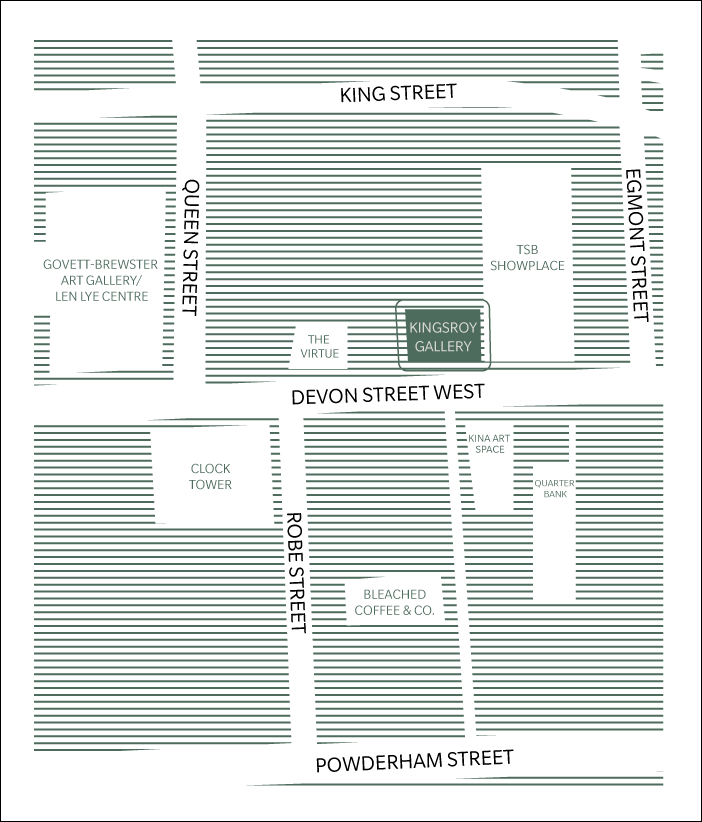The paintings speculate on documented relations between the colonial government and allied Māori on one side, and Māori and Māori-allied settlers on the other. Over the past decade, this (sometimes undocumented) period of history has become a unique artistic opportunity to reimagine pre-settled land.
Through predominantly large-scale paintings, the interweaving of histories, pictures and stories from this period, as told by both local Iwi and Pākehā, becomes rewritten.
The namesake of this series, Māoriland, was a term used by Pākehā in the colonial period as an advertorial slogan. Māoriland misrepresented Aotearoa as a place of racial harmoniousness where both Pākehā and Māori lived at ease under a colonial government; however, the paintings in this series signal otherwise.
The unifying theme of this series is the enchanted natural landscape of Aotearoa, a landscape that has an accompanying mythos that is alien to Pākehā colonisers.
Pākehā settlers act as a violent introduction to Enlightenment thought and action. Throughout the series, Māori and the primordial bush of Aotearoa enchant the icons and ideas of Pākehā, even as Pākehā exert their slow profanation of the wild. This theme of enchantment is explored through naive pictorial practices as found in early settler art and the figurative art within the painted Marae of the prophetic Māori faiths.
The Scouting Party
The Scouting Party is the third collection of works thus far in Jackson's Tales from the Māoriland. A key thread in the series is exploring the shifting nature of relationships that can occur with internal conflicts/civil wars. With wars between nations, the definition of the enemy is more well-defined. With civil war, however, the enemy is less easily defined, alliances can shift over time – Māori fought against Māori, and some Pākehā fought against Pākehā. At times, there is peace and an uneasy truce across the land, at other times, localised conflicts will flare up.
This series follows the journeys of Thomas McDonnell and Charles Heaphy, colonial soldiers traversing across the land, here again presented as both a Garden of Eden and Canaan – the promised land of the Israelites. McDonnell and Heaphy are presented as stand-ins for the viewer. Their faces are turned askance, towards the landscape, or present symbolically, allowing entry into the wondrous landscape of the myth-infused pre-settled Aotearoa.
Once again, Archangels are used to represent Pai Mārire peoples and faith, however in this series perspective shifts between McDonnell/Heaphy, and Pai Mārire. This shifting of perspective centres the question of otherness present within this clashing of cultures, focusing on the unfolding nature of the relationship. At times, this relationship is depicted as simmering with violence, at other times peace and union hover on the horizon.
The biblical story of Joshua and Caleb runs through this series as a theme that highlights the shifting of perspectives and plays with the opaque shield of othering present in the colonial wars. Pai Mārire’s unique understanding of and identification with the Israelites becomes manifest in their imagined status as Archangels. The Scouting Party, however, muddies this reference by establishing McDonnell and Heaphy as uneasy stand-ins for Joshua and Caleb, scouting the land, and in the realm of giants.
Throughout Jackson's work, the Pai Mārire faith has been linked with the Israelites. In The Scouting Party this link has been inverted, now the Scouts are traveling a new land, up and down New Zealand. This series documents these travels, presenting them as an odyssey, filled with strange and ambiguous encounters with the Māori and the new land. This odyssey is not presented as a straightforward story, instead, moments are captured that exist inside the story, gaps that open out onto the ambiguous and ambivalent relationships that enact the land wars. In many ways The Scouting Party is a departure for Jackson, the paintings move out of Taranaki, with the scouting party themselves operating as vehicles to traverse landscapes both imagined and real.







